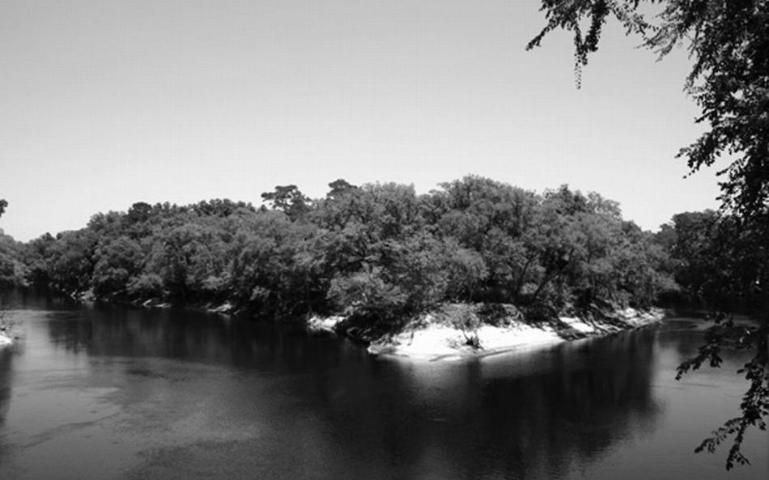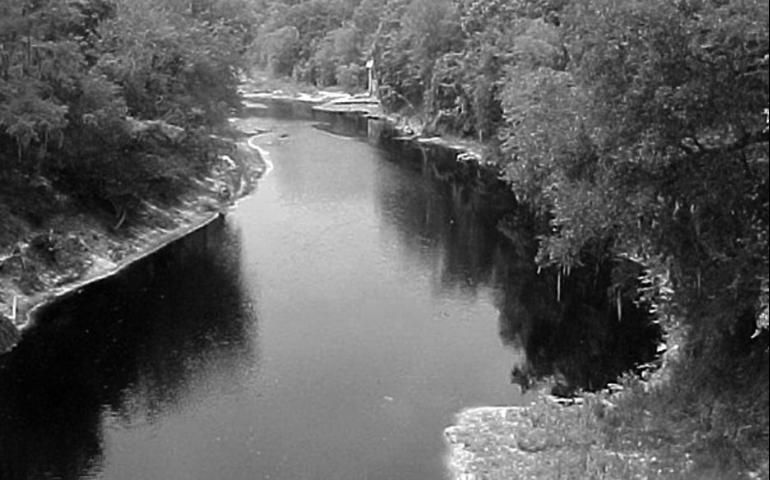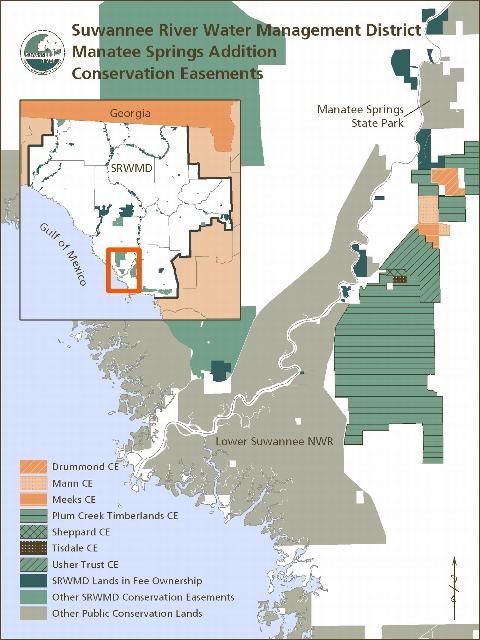Agencies differ in the tools that they use to address problems in the wildland-urban interface and protect natural resources across the landscape. For example, some agencies can acquire or facilitate the acquisition of conservation easements (or land-preservation agreements). Conservation easements (voluntary donations or purchases of property rights for the purpose of restricting development) can be a powerful tool for conserving natural resources, improving management opportunities, and protecting connectivity in interface areas.
The Suwannee River Water Management District (SRWMD) is one agency that is using the tool of conservation easements with great success. The district is one of five regional water management districts in Florida. It was created by the Florida legislature through the Water Resources Act of 1972. The objectives of this agency are to manage water and related natural resources in north central Florida by providing water quality and quantity monitoring, research, regulation, land acquisition and management, and flood protection. The SRWMD aims to balance public access, recreational use, and restoration and protection of natural lands when making management decisions.

Credit: Florida DEP
In 1999 the Florida Forever land acquisition program was founded. This program aims to conserve and protect natural resources by acquiring and protecting land on behalf of the citizens of Florida. Under the sponsorship of the Florida Forever program, SRWMD promotes conservation easements as a cost-effective means to protect natural resources and provide buffers for their management areas. A conservation easement enables a landowner to retain the title to his or her property but transfers subdivision and development rights to the district, and restricts certain land uses. In most cases, landowners can still manage their lands for products and services, such as timber production and wildlife habitat enhancement, but they must agree to develop annual management plans in cooperation with the district. According to the project coordinator for the SRWMD Acquisition and Management Program, conservation easements are an attractive mechanism for both landowners and the agency. Landowners are able to preserve their property by selling certain development and use rights while continuing to own it, and the agency is not burdened with a purchase of the entire property. The easement typically becomes part of the land title and is transferred with the land to all future owners.
Conservation easements have many advantages. One advantage is that the landowner retains most of the responsibilities for owning and managing the land, which is often ideal for the landowner. This brings a second advantage—the acquisition cost to the agency is much lower than the outright purchase of land at market value. In addition, the cost of managing the land is not the agency's responsibility. Both factors enable the agency to conserve more acres with limited funds. The fact that easements can be tailored to address precisely the resource concerns or objectives that the agency wishes to protect means a unique easement can be crafted to meet the landowner and agency needs. By removing the development rights from the property, the tax burden to the landowner is usually reduced since the potential value of the land has been reduced. Another advantage is that conservation easements can be selectively designed to serve as buffers for the lands the district has conserved by outright purchase. Many find that the conservation easement creates a beneficial relationship between the agency and the landowner, which can result in technical assistance or local knowledge for management projects. And finally, by continuing to keep the land economically productive, the community can benefit from the goods or jobs that the activity generates.

Credit: Florida DEP
The SRWMD conservation easement program has contributed to many ecological improvements in a short time. Along the Aucilla River, easements acquired by SRWMD together with those acquired by the Tall Timbers Land Conservancy provide a protected corridor along much of the river. In Levy County, the conservation of the Suwannee River floodplain by way of easements across seven ownerships creates a 21,000-acre greenway and wildlife corridor linking Manatee Springs State Park and the Lower Suwannee National Wildlife. The district relies primarily on word-of-mouth to promote this program but also distributes brochures and speaks to civic organizations. As of 2009, the district had successfully purchased the development rights of more than 147,000 acres using conservation easements complementing an additional 14,000 acres of donated mineral rights.

Credit: Map courtesy of SRWMD
Many of the land management agencies use a variety of land conservation tools as they work with private landowners to determine the most appropriate strategies to protect natural resource goods and services for the future. Protecting the Suwannee River floodplain will enhance recreational values and the wildlife corridor, as well as reduce the likelihood of the loss of human life due to catastrophic flooding. While these lands may not be close to urban areas today, their development would bring urbanization close to wildlands in the future, and their protection now allows for possibilities that may not exist in several decades. For more information about land conservation, contact the land acquisition and management department at SRWMD, https://www.mysuwanneeriver.com/.
Sources
Demott, T., Projects Coordinator for Acquisition and Management Program, Suwannee River Water Management District. Personal interview, April 5, 2005.
Florida Forever. 2011. Work Plan online. http://sjrwmd.com/landacquisition/pdfs/Florida_Forever_Update.pdf (accessed March 16, 2011).
Florida Forever website. https://floridadep.gov/lands/environmental-services/content/florida-forever (accessed May 2022).
Please consider accessing these related documents
Living Green: Conservation Easements https://livinggreen.ifas.ufl.edu/tv-episodes/conservation-easements/
Demers C. and D. R. Carter. Conservation Easements: Options for Preserving Current Land Uses. SSFOR21. Gainesville: University of Florida Institute of Food and Agricultural Sciences. https://edis.ifas.ufl.edu/publication/FR149